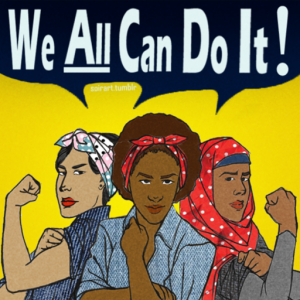![]()
Employee Resources Groups (ERGs): Are they the golden ring towards which agencies should reach? Or are they over-hyped and underutilized? As with many seemingly dualistic questions, the truth usually lies somewhere in the middle and depends on a myriad of factors within our direct control, either as ERG members, or as agency executives.
ERGs are defined as voluntary employee-led affinity groups created within organizations and convened around common interests, issues, and/or a common bond or background. Such groups are often created with the goal of fostering a diverse and inclusive culture within an agency or organization. However, diversity and inclusion efforts – including ERGs – have been around for over thirty years and such programs and initiatives have made little measurable progress over that time. When done right, I believe ERGs have an almost limitless ceiling; with the ability to foster adaptive leadership through intersectional diversity.
A global world and the nature of adaptive challenges
As discussed in a previous article, our world today is more complex, and interconnected than ever before. Consequently, even the most outwardly simple technical challenges may have adaptive components. Dean Williams, in his excellent book Leadership for a Fractured World, describes the leadership needed to help groups transcend our tribal impulses and solve interdependent problems. By “tribal” Williams refers to our tendency to affiliate ourselves with groups that “inform our identify and from which we derive meaning.” Social science research on group behavior supports this idea of tribalism and explains how it generates “in” groups and “out” groups. According to the legendary E.O. Wilson: “human beings have innate tendencies, predispositions, and emotional capacities that lead us to identify with a group or tribe that provides fellowship, protection, coordinating mechanisms, parameters for action, and frameworks for interpreting the human experience.” The cultures of our respective groups and the roles we play within them cause us to view problems through the narrow lens of group interest. As a result, we often see only one piece of a complex problem, and end up working on our own small piece of the pie, without making much progress.

An example comes out of Williams’ time working in Madagascar. A development project in a local village failed largely because of a lack of adaptive understanding. Developmental NGO personnel constructed a well and water pump in a village because they believed it would solve a simple (technical) problem. The women of this village spent significant time and effort each day walking to retrieve water from a nearby river. The intention of the well was to “fix” this problem. Just two weeks after installation however, the well and the pump lay in ruins. It had been destroyed by the intended beneficiaries; the women of the village. Why? In short, the well was seen as an unwelcome disruption to their traditional pattern of living, which included walking with their sisters and daughters in a daily ritual to fetch water. (It also meant the women had to spend more time in the village with the “annoying” men!) In the rush to solve the “problem”, no one in the NGO had thought to ask if the women wanted the well. This outside group did not fully understand the adaptive nature of the situation.
The role for ERGs
By this point, we may start to see where ERGs can aid in addressing adaptive challenges. Likewise, we start to see where they may fall short. By their very nature, ERGs are groups drawn together from powerful shared interests or backgrounds. Although this makes them strong, it also risks making them insular. Without intentional boundary-spanning work, we risk our ERGs becoming clubs of insiders, reinforcing our tribal natures and insulating us from others. To combat this, we must leverage intersectionality.
Intersectionality is the notion that “social identities such as race, gender, sexuality, class, marital status, and age, overlap and intersect in dynamic ways that shape each individual.” In other words, all of us possess more than one social identity. Recognizing that interdependent problems cannot be solved by one group acting alone in isolation, we must work leverage these connections to cross the boundaries of our groups and partner with others to develop innovative solutions.
A diverse, intersectional ERG program can offer a powerful network of partners to help agencies and employees navigate the difficult terrain of interdependent challenges. To be successful, ERGs and agencies must consciously enter into the terrain of the “other.” Each must seek out diverse and even competing perspectives to generate a more complete understanding of the challenge.

Each of us can be a leader
In this new world, anyone committed to making the world a better place can be a leader. Leadership is needed at all levels of agencies. ERGs offer agencies the means to empower passionate, motivated change agents with a platform to fulfill their potential. To be truly effective however, ERGs must work with each other and with the agency Senior agency leaders must likewise be intentional in engaging with and utilizing ERGs to their fullest potential in order to achieve the full benefit of these groups.
Crossing boundaries is neither easy, nor natural. Doing so means we must leave a state of predictability and safety for one of vulnerability and uncertainty. We must be aware of the perceived threat we may pose to other groups and must partner with other like-minded leaders if we wish to succeed. We must also challenge our own groups’ boundaries and help members realize what is at stake if we do not build intersectional bridges, harness the power of diversity to foster innovation and achieve breakthrough solutions. The success of government in our modern world depends upon each of us.
Dylan Mroszczyk-McDonald is part of the GovLoop Featured Blogger program, where we feature blog posts by government voices from all across the country (and world!). To see more Featured Blogger posts, click here.





The problem with employee resource groups in the federal government is they receive competition from the 20th Century institutionalization of special emphasis programs. Until we can rid ourselves of special emphasis programs and their once a year cultural events like taco eating contests and belly dancers, the promise of employee resources groups will probably not be fulfilled.